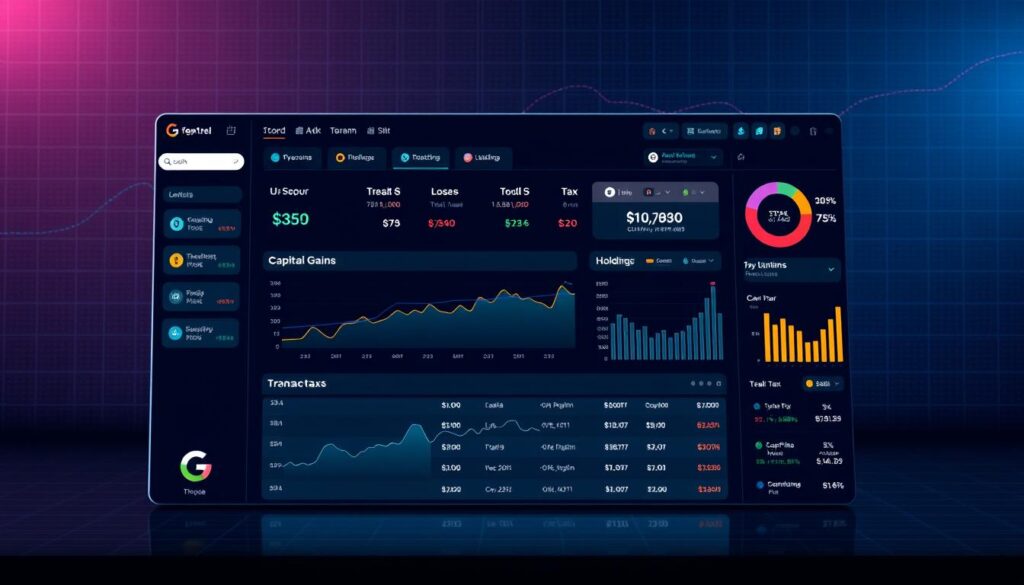Now Reading: Cryptocurrency tax reporting capital gains: Rules and Regulations
- 01
Cryptocurrency tax reporting capital gains: Rules and Regulations
Cryptocurrency tax reporting capital gains: Rules and Regulations

Navigating the world of digital assets can be exciting, but it also comes with important responsibilities. As more people buy, sell, and trade crypto, understanding the financial rules is crucial. This guide will help you grasp the essential regulations for your digital investments.
The IRS treats digital currencies as property, not cash. This means every transaction can create a taxable event. Properly tracking your activity helps you avoid costly mistakes and potential penalties from the government.
Our guide covers everything from the basic principles to more advanced strategies. You will learn about different transaction types, how to calculate your cost basis, and when it might be time to seek professional advice. Staying informed is the first step toward confident and compliant management of your portfolio.
Key Takeaways
- The IRS classifies digital currencies as property, creating potential tax events with most transactions.
- Accurate record-keeping is essential for calculating your cost basis and determining your final liability.
- Different activities, like trading and staking, have unique tax implications that must be reported correctly.
- Using the proper federal forms is a critical part of staying compliant with current regulations.
- Understanding these rules can help you minimize your financial burden through legitimate strategies.
- Seeking guidance from a qualified professional is often a smart move for complex situations.
Introduction to Cryptocurrency Tax Fundamentals
Before diving into complex trading strategies, grasping one essential IRS ruling will clarify your entire tax picture. The agency’s Notice 2014-21 established that crypto is treated as property rather than currency. This classification shapes how every transaction gets handled.
This property status means your digital assets receive similar treatment to stocks or real estate. When you sell or exchange them, standard investment rules apply. Understanding this foundation affects all your crypto activity.
The IRS has made compliance a priority by adding specific questions to Form 1040. Unlike traditional currency exchanges, swapping one virtual currency for another creates a reportable event. You must track all transactions throughout the year.
Starting January 1, 2025, all crypto sales must be reported to the IRS. This marks increased regulatory oversight. Proper recordkeeping becomes even more crucial for digital asset holders.
Understanding Capital Gains in Cryptocurrency
Your profit from a sale is not taxed uniformly. The holding period creates two separate categories with vastly different implications.
This distinction is fundamental for financial planning. Knowing the rules helps you make smarter decisions about when to sell your assets.
Long-Term vs. Short-Term Gains
The split is simple. If you owned the asset for one year or less, any profit is considered a short-term capital gain.
Ownership lasting more than a year qualifies for long-term capital gains treatment. The difference in rates is substantial.
How Ordinary Income Rates Apply
Short-term gains are added to your yearly earnings. They are subject to ordinary income tax rates.
These rates can be as high as 37%. Long-term gains, however, benefit from much lower federal rates of 0%, 15%, or 20%.
| Holding Period | Gain Classification | Applicable Tax Rates |
|---|---|---|
| 1 year or less | Short-Term | Ordinary Income Rates (10% – 37%) |
| More than 1 year | Long-Term | Preferential Rates (0%, 15%, 20%) |
Waiting until you cross the one-year threshold can significantly reduce your liability. This rule strongly favors a patient investment strategy over frequent trading.
Your specific rate within each bracket depends on your total income and filing status. Properly tracking the purchase and sale dates for every transaction is essential.
IRS Guidelines for Reporting Crypto Transactions
Recent regulatory changes have established definitive procedures for declaring blockchain-based financial activities. The framework now requires specific documentation for all digital asset movements.
Starting with the 2024 tax year, Form 1040 features a prominent question about virtual currency involvement. This placement underscores the seriousness of compliance requirements.
Key Reporting Requirements from the IRS
The agency mandates disclosure of various digital asset activities. These include:
- Exchanging one virtual currency for another
- Using digital assets to purchase goods or services
- Receiving crypto as payment for work performed
- Selling digital holdings for traditional currency
Beginning January 1, 2025, all sale transactions must be reported to federal authorities. Exchanges now provide Form 1099-B documentation similar to traditional brokerage reporting.
Some activities don’t trigger immediate reporting obligations. These include transferring between personal wallets and purchases held without subsequent transactions.
Accurate record-keeping remains essential despite exchange reporting. Taxpayers maintain ultimate responsibility for proper declaration of all taxable events.
Determining Your Cost Basis and Transaction Details
Calculating your profit or loss on digital assets starts with one fundamental number: your cost basis. This figure represents your original investment.
Your basis is generally the price you paid. You must also include any fees from the purchase. This gives you your adjusted cost basis.
When you sell, you determine the final sale amount. Remember to subtract any fees paid to complete the sale. This is your adjusted proceeds.

The basic math is simple. Subtract your adjusted basis from your adjusted sale amount. A positive result is a gain. A negative result is a loss.
Tracking key details for all your crypto transactions is non-negotiable. You need the purchase date, price, and fees. You also need the sale date, price, and fees.
This becomes complex with multiple purchases. Using different accounting methods like FIFO or specific identification can change your cost basis. This directly affects your final tax amount.
Meticulous records make this process manageable. Good documentation supports your calculations if questions arise.
Filing Your Crypto Transactions on Federal Tax Forms
Completing your annual financial declaration requires careful attention to specific government documents for digital asset activities. The process involves multiple forms that work together to create a complete picture of your financial movements.
Utilizing Form 8949 for Accurate Reporting
Form 8949 serves as your detailed transaction ledger for all digital asset sales and exchanges. You must list each individual event separately, including dates, amounts, and resulting profits or losses.
The form requires separation by holding period and whether your exchange provided documentation. Even without official paperwork, you still need to complete this form accurately.
Integrating Schedule D for Capital Gains
After detailing all transactions on Form 8949, you transfer the totals to Schedule D. This form consolidates your digital asset results with other investment activities.
Schedule D calculates your final net gain or loss by combining short-term and long-term results. The final figure then flows to your main Form 1040.
This systematic approach ensures proper declaration of all financial movements. Maintaining organized records throughout the year makes this process much smoother.
Navigating Cryptocurrency Tax Software Options
Modern digital asset management tools can transform a complex tracking chore into a streamlined process. Specialized platforms are designed to handle the unique demands of your portfolio.
These programs connect directly to your trading accounts. They automatically pull your entire history of buys, sells, and swaps.

This automation is the core strength of these solutions. You avoid the risk of manual entry mistakes.
Benefits of Automated Data Import
The software syncs with major platforms to gather all necessary details. It collects dates, amounts, fees, and cost basis information seamlessly.
Most exchanges allow you to download your activity as a CSV file. The best programs can import these files directly to populate your records.
This feature saves countless hours of work. It is especially valuable for investors with activity across multiple venues.
| Software Type | Primary Focus | Ideal User |
|---|---|---|
| Specialized Crypto Platforms | Deep integration with exchanges and complex crypto activities | Active traders, DeFi users |
| Mainstream Tax Programs | Adding crypto handling to general income tax preparation | Investors with simpler digital asset holdings |
Once your data is imported, the software calculates your gains or losses. It applies the correct holding periods and accounting methods.
The final output is a pre-filled Form 8949, ready for review. While highly accurate, a final personal check of the forms is always recommended.
Managing Cryptocurrency Tax Reporting Capital Gains
Many investors mistakenly believe they owe money on paper profits, but the reality is quite different. You only face financial obligations when you actually dispose of your digital assets.
Selling, trading, or using your holdings for purchases creates taxable events. Simply buying and holding generates no immediate liability. This distinction between realized and unrealized gains is fundamental to proper portfolio management.
Your taxable profit equals the sale amount minus your adjusted basis. This includes original cost plus any fees. If you purchased $100 worth of crypto that grows to $200, you owe nothing until you sell.
Strategic planning around timing can significantly impact your financial outcome. Waiting to qualify for long-term treatment or spreading sales across years are smart approaches. Understanding fair market value at transaction time is critical for accurate calculations.
Proactive management throughout the year beats last-minute scrambling. Detailed records of dates, amounts, and values make reporting simpler. Many investors benefit from specialized tracking tools that automate this process.
A systematic approach to monitoring all activity helps you make informed decisions. Proper documentation supports your calculations and ensures compliance with current regulations.
Understanding Tax Implications of Crypto Exchanges
Your choice of trading venue directly impacts how you’ll document your investment activities for regulatory purposes. These platforms have become essential partners in financial compliance.

Starting with the 2023 tax year, major platforms must provide Form 1099-B to users. This document reports your sales proceeds and sometimes includes cost basis information.
The IRS receives identical copies of these forms. They use them to verify that you’ve reported all taxable transactions accurately.
Not every platform provides official documentation. Smaller or international exchanges may only offer basic transaction histories. You remain responsible for reporting all activity regardless.
Using multiple exchanges complicates your financial picture. You must combine data from all platforms to get a complete view of your digital assets activity.
If your calculations differ from the exchange’s reported numbers, you can make adjustments on Form 8949. This allows you to explain any discrepancies to authorities.
Understanding what your exchange provides helps you identify gaps in your records. Proactive tracking throughout the year ensures smoother filing when deadlines approach.
Special Cases: Staking, Mining, and Airdrops
Staking, mining, and airdrops represent special scenarios with distinct compliance requirements. These activities generate immediate financial obligations that differ from standard trading.
Tax Treatment for Rewards and Forks
The IRS treats staking rewards as ordinary income when you receive them. You must report the fair market value at the time of receipt.
Mining activities follow similar rules. Successful mining creates taxable income based on the coins’ value when mined.
Airdrops and hard forks also trigger reporting requirements. When you receive free tokens through marketing distributions or blockchain changes, you have taxable income.
For detailed guidance on forked coins tax treatment, consult specific resources. These special cases require careful tracking of receipt dates and values.
Platforms may provide Form 1099-MISC or 1099-NEC for these activities. You must report this income even without official documentation.
Tax-Loss Harvesting Strategies for Cryptocurrency
Smart investors turn market downturns into financial advantages through strategic planning. This approach involves intentionally realizing losses to create beneficial financial outcomes.
When you sell digital assets for less than your purchase price, you create opportunities to reduce your overall financial obligations. These calculated moves can significantly impact your annual financial picture.

Offsetting Gains with Reported Losses
The core strategy involves using your documented losses to counterbalance profits from other investments. This applies to both digital asset sales and traditional investment gains.
If your total losses exceed your profits for the year, you gain additional benefits. You can deduct up to $3,000 against your regular earnings. Any remaining amount carries forward to future years.
Strategic timing is crucial for maximizing these benefits. Realizing losses during high-profit years creates the most significant financial advantage. This approach requires careful planning throughout the year.
Unlike traditional securities, digital assets currently avoid certain restrictive regulations. This flexibility allows for more aggressive loss-harvesting approaches. However, maintaining detailed records remains essential for compliance.
Combining this strategy with long-term holding periods creates a comprehensive approach to portfolio management. Proper documentation supports all calculations and ensures accurate financial reporting.
Practical Tips for Accurate Crypto Recordkeeping
Building a solid recordkeeping system is your first line of defense against crypto tax complications. Consistent documentation throughout the year prevents last-minute scrambling during filing season.
Track every transaction with essential details. You need dates, amounts, fair market value in USD, and all fees. This information forms your cost basis for accurate calculations.
Create a dedicated system for your crypto activity. Use spreadsheets, specialized software, or detailed notes. Systematic organization makes reconstruction unnecessary.
Download your transaction history regularly from all exchanges. Save these files as CSV format or account statements. Some platforms delete older data, so quarterly downloads are smart.
For multiple purchases at different prices, document which specific units you sell. This supports your chosen accounting method and ensures proper basis calculations.
Keep wallet addresses for transfers between your own wallets. This proves they’re non-taxable movements rather than sales. Maintain documentation for at least three years after filing.
Consider blockchain explorers if exchange records are incomplete. Screenshots and transaction confirmations provide valuable backup. Thorough records support your figures if questions arise.
Expert Advice and When to Consult a Tax Professional
Certain investment scenarios in the blockchain space clearly signal the need for professional tax assistance. While many investors can handle basic reporting, complex situations demand specialized expertise.
A qualified tax professional brings valuable knowledge to navigate intricate financial landscapes. Their guidance can protect you from costly errors and optimize your financial outcomes.
Indicators That You Need Professional Guidance
High-volume activity is a major red flag. Managing hundreds of crypto transactions manually becomes overwhelming and error-prone.
Complex portfolio elements also warrant expert help. On-chain activities, DeFi involvement, or using international exchanges create additional compliance challenges.
Older investments purchased before 2016 often lack proper documentation. Reconstructing accurate records requires professional research techniques.
Self-employed individuals earning crypto income face Schedule C complexities. A tax professional ensures proper handling of self-employment obligations.
Even without obvious complexity, consulting an expert provides peace of mind. They stay current with evolving regulations and can identify optimization opportunities you might miss.
The investment in professional guidance often pays for itself through identified savings and reduced audit risk.
Staying Updated with Evolving Crypto Tax Regulations
Keeping pace with the shifting rules for blockchain investments is a critical task. The regulatory environment for digital assets changes quickly. New guidance from authorities can directly impact your financial obligations.
Recent years have seen a significant increase in enforcement efforts. The IRS now requires more detailed disclosure of your activities. This heightened scrutiny makes accurate compliance more important than ever.
A major change takes effect on January 1, 2025. From that point forward, all sale transactions involving digital assets must be reported. This represents a substantial shift in oversight for the entire industry.
Staying informed helps you avoid surprises. New rulings can affect what counts as a taxable event. They can also change how you calculate your profits or losses for the year.
| Change | Description | Effective Date |
|---|---|---|
| Form 1040 Question | Mandatory disclosure question about virtual currency activity added to the main tax form. | Tax Year 2020 |
| Broker Reporting | Exchanges must provide Form 1099-B documentation for user sales, similar to traditional brokers. | Tax Year 2023 |
| Comprehensive Sales Reporting | All digital asset sale transactions must be reported to the IRS. | January 1, 2025 |
The treatment of new technologies like DeFi and NFTs continues to develop. Following reputable sources for news is a smart strategy. Consulting a professional before filing ensures you use the most current rules.
Building a habit of checking for updates throughout the year allows for proactive adjustments. This approach leads to smoother and more confident management of your portfolio.
Conclusion
Success in the digital currency space hinges on understanding and applying proper financial documentation practices. The journey toward compliant crypto management begins with mastering fundamental principles.
Consistent record-keeping throughout the year prevents last-minute challenges. Utilizing specialized software and knowing when to seek professional guidance significantly improves accuracy.
Remember that digital asset obligations extend beyond simple trading activities. Staking rewards, mining income, and other crypto earnings require proper declaration on your annual tax return.
As regulations continue to evolve, staying informed remains an ongoing responsibility. Applying these strategies ensures confident management of your capital gains and overall financial compliance.
FAQ
What is considered a taxable event for my digital assets?
A taxable event occurs when you sell, trade, or spend your virtual currency. Exchanging one asset for another, like Bitcoin for Ethereum, is a sale. Using crypto to buy goods or converting it to U.S. dollars also triggers a reportable event. Receiving staking rewards or airdrops counts as ordinary income.
How do I calculate my profit or loss on a sale?
To find your gain or loss, subtract your cost basis from the fair market value at the time of the transaction. Your basis is typically what you paid for the asset, including fees. Accurate recordkeeping of every purchase and sale is essential for this calculation.
What is the difference between long-term and short-term holdings?
If you hold a digital asset for more than one year before selling, it qualifies for long-term treatment. These profits often benefit from lower income tax rates. Sales of assets held for one year or less are short-term and are taxed at your standard income rate.
Do I need to report crypto on my return if I didn’t sell any?
Yes, you might still have reporting obligations. If you earned any rewards from staking or mining, that is considered taxable income for the year it was received. You must report this amount even if you never sold the new assets.
Which forms do I use to file my virtual currency transactions?
A> Most individuals report their transactions using Form 8949, Sales and Other Dispositions of Capital Assets. The totals from this form then transfer to Schedule D of your Form 1040. Software like CoinTracker or Koinly can help prepare these documents.
Can I use a loss from one transaction to reduce my overall bill?
Yes, this strategy is known as tax-loss harvesting. You can use a capital loss to offset capital gains from other sales. If your total losses exceed your gains, you can deduct a limited amount against other income.
When should I consider hiring a professional for help?
It’s wise to seek expert advice if you have a high volume of transactions, complex situations like mining income, or if you are unsure about your cost basis calculations. A qualified CPA or enrolled agent can ensure compliance with evolving regulations.














